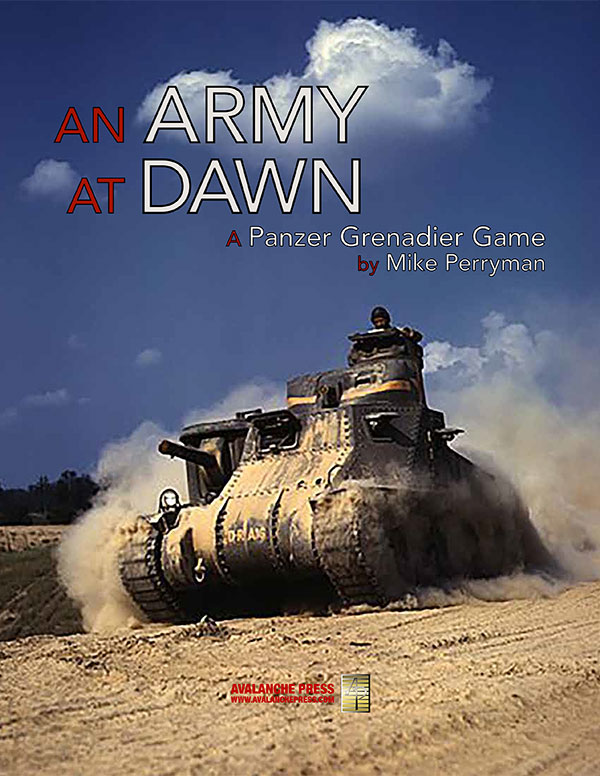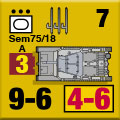| An Army at Dawn (Playbook Edition):
Publisher’s Preview
By Mike Bennighof, Ph.D.
April 2024
 An Army at Dawn has been one of our most popular Panzer Grenadier games. It brings the U.S. Army’s role in the North African desert war to your game table, and covers not only the American campaign in Tunisia, but also the Vichy/Free French (same guys, different sides), British, Germans and Italians. And now An Army at Dawn is back in a Playbook edition. An Army at Dawn has been one of our most popular Panzer Grenadier games. It brings the U.S. Army’s role in the North African desert war to your game table, and covers not only the American campaign in Tunisia, but also the Vichy/Free French (same guys, different sides), British, Germans and Italians. And now An Army at Dawn is back in a Playbook edition.
When we switched from boxed format to Playbook, that gave us an excuse to re-make the scenario book for An Army at Dawn, since it would have to be laid out all over again. And so designer Mike Perryman had a green light to re-make the scenario set: 35 of them are revised versions of the scenarios from the boxed edition, and five more are brand-new for the Playbook.
The Playbook edition has everything you need to play, except for dice, and a box, which you don’t need to play anyway.
At the heart of any game are its rules: they are the software that makes all of that pretty hardware go. An Army at Dawn carries the Fourth Edition rules for Panzer Grenadier, streamlined for even easier play but continuing all the same concepts that have made the series so popular. If you’ve played a Panzer Grenadier game, you’ll be able to play this one as soon as you open the box, pick a scenario and set it up. If not, you can learn how in just a few minutes. This time out there are full-color play aids, and a new marker sheet that’s best described as “very colorful.”
 With those rules, you can play the 40 scenarios, all designed by Mike Perryman, designer of many Panzer Grenadier games including Burning Tigers and Liberation 1944. For the Playbook edition, the scenarios are now in our story-arc format, organized in chapters to follow the campaign from the initial landings through the fall of Tunis, with battle games to link the scenarios of each chapter together. The game is now tightly focused on the operations of the U.S. 1st Armored Division, but we also see the British and French fighting for the Allies and the Germans, Italians and the French fighting for the Axis (it was a confusing time to be a French soldier). With those rules, you can play the 40 scenarios, all designed by Mike Perryman, designer of many Panzer Grenadier games including Burning Tigers and Liberation 1944. For the Playbook edition, the scenarios are now in our story-arc format, organized in chapters to follow the campaign from the initial landings through the fall of Tunis, with battle games to link the scenarios of each chapter together. The game is now tightly focused on the operations of the U.S. 1st Armored Division, but we also see the British and French fighting for the Allies and the Germans, Italians and the French fighting for the Axis (it was a confusing time to be a French soldier).
The campaign begins with Anglo-American landings in Algeria, resisted by the French garrison there. The Americans and British quickly press into Tunisia, where they meet the Germans and Italians. The Axis are much more skilled in armored warfare than the Americans, who aren’t helped any by their shoddy equipment (37mm anti-tank guns and halftrack-mounted “tank destroyer” low-velocity 75mm, fielded well after these weapons have been shown inadequate in Egypt and Russia). But eventually the Axis are pressed back into an ever-tightening bridgehead, even as they continue to put up fierce resistance.
 As with most Panzer Grenadier games, the scenarios have a wide scope. There are tank battles, like Kasserine Pass. There are close-quarters infantry fights, and combined arms clashes. Most of the scenarios are what I’d consider mis-sized; six of the 40 use one mapboard, but only one uses all four. All of the rest use two or three. As with most Panzer Grenadier games, the scenarios have a wide scope. There are tank battles, like Kasserine Pass. There are close-quarters infantry fights, and combined arms clashes. Most of the scenarios are what I’d consider mis-sized; six of the 40 use one mapboard, but only one uses all four. All of the rest use two or three.
The maps themselves are Guy Riessen desert specials, very similar to 1967: Sword of Israel’s maps in look and content. There’s only one town among the four boards, and a lot of hills and rocky ground. Tunisia is a very lonely place.

The American forces suffer somewhat from President Roosevelt’s decision to ship the very best new equipment to the British. So although the M4 Sherman tank had already seen combat with the British at Alamein by this point, the American 1st Armored Division went into action with the inferior M3 Lee. Other crapulent American weaponry includes the 37mm anti-tank gun (the 57mm gun, actually capable of knocking out German tanks, was available but not issued), the M6 tank destroyer (the useless 37mm gun mounted on a Dodge truck; the M10 tank destroyer with a potent 3-inch gun on a modified Sherman chassis had begun production in September), and the T12 half-track tank destroyer mounting a license-made French 75, a fine weapon when introduced in 1897 (see preceding).
 The M10 and the M4 Sherman do finally make an appearance in the later scenarios, though by this point the Germans have the Panzer IVH with its tank-killing long-barreled 75mm gun and the awesome Tiger tank. American infantry is well-armed, and their machine gun platoons are very potent, but these are very raw troops and their leadership, morale and initiative are seldom very good. The M10 and the M4 Sherman do finally make an appearance in the later scenarios, though by this point the Germans have the Panzer IVH with its tank-killing long-barreled 75mm gun and the awesome Tiger tank. American infantry is well-armed, and their machine gun platoons are very potent, but these are very raw troops and their leadership, morale and initiative are seldom very good.
While the Arsenal of Democracy has failed its ground troops, this is the United States of America we’re talking about here. That means they have plenty of air power to back up the troops, and pretty awesome off-board artillery. They’re going to need both of them.
 The Germans, on the other hand, know the business of war and bring pretty potent weaponry to the battlefield. They have the same “desert” pattern as the Germans in our out-of-print games set in North Africa, though very few of them are actually part of the old Afrika Korps. The Germans hold a serious edge in armor quality, with not only the Tiger but the PzIVH and PzIVF2 with the long-barreled 75mm gun, and the PzIIIJ with the long-barreled 50mm gun. Other than that, they have the expected foot soldiers and support weapons, some of them not seen in North Africa before, like the StuGIIIG assault gun and 75mm infantry gun. They also have a small contingent of paratroopers The Germans, on the other hand, know the business of war and bring pretty potent weaponry to the battlefield. They have the same “desert” pattern as the Germans in our out-of-print games set in North Africa, though very few of them are actually part of the old Afrika Korps. The Germans hold a serious edge in armor quality, with not only the Tiger but the PzIVH and PzIVF2 with the long-barreled 75mm gun, and the PzIIIJ with the long-barreled 50mm gun. Other than that, they have the expected foot soldiers and support weapons, some of them not seen in North Africa before, like the StuGIIIG assault gun and 75mm infantry gun. They also have a small contingent of paratroopers
Among the minor players, the Italians are actually pretty good, with a lot of high-morale Bersaglieri present and only their most modern tank, the M14/41. Which is still not all that good, but when the Americans are shooting at it with their noodle-firing 37mm guns, it will suffice. Against the tiny British contingent, the Italians don’t look so bad, but at least the Brits have a workable anti-tank weapon (just one) with their six-pounder. The French, on the other hand, are kind of pitiful, with weak infantry, no armor and limited support weaponry, though their leadership is surprisingly good (as befits units of long-service professionals).
 The pieces themselves are the new-style silky-smooth die-cut pieces we’ve started using. There’s very little die-cutting damage on them. Since there are no tell-tale smash marks to help you tell the front from the back, we’ve added a thin stripe back there to help with that. These are very fine game pieces, and you’ll enjoy playing with them. The pieces themselves are the new-style silky-smooth die-cut pieces we’ve started using. There’s very little die-cutting damage on them. Since there are no tell-tale smash marks to help you tell the front from the back, we’ve added a thin stripe back there to help with that. These are very fine game pieces, and you’ll enjoy playing with them.
All of the Playbook games are really nice packages; we’ve given them a needed story structure to go along with the color play-aids new-style pieces, and the fine Riessen maps.
You can order An Army at Dawn right here.
Big Red Package
An Army at Dawn
Big Red One
Retail Price: $92.98
Package Price: $85
Gold Club Price: $68
You can order the Big Red Package right here.
Sign up for our newsletter right here. Your info will never be sold or transferred; we'll just use it to update you on new games and new offers.
Mike Bennighof is president of Avalanche Press and holds a doctorate in history from Emory University. A Fulbright Scholar and NASA Journalist in Space finalist, he has published a great many books, games and articles on historical subjects; people are saying that some of them are actually good.
He lives in Birmingham, Alabama with his wife, three children, and new puppy. He misses his lizard-hunting Iron Dog, Leopold.
Want to keep Daily Content free of third-party ads? You can send us some love (and cash) through this link right here.
|
